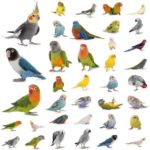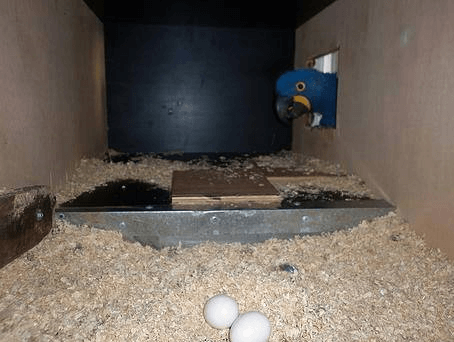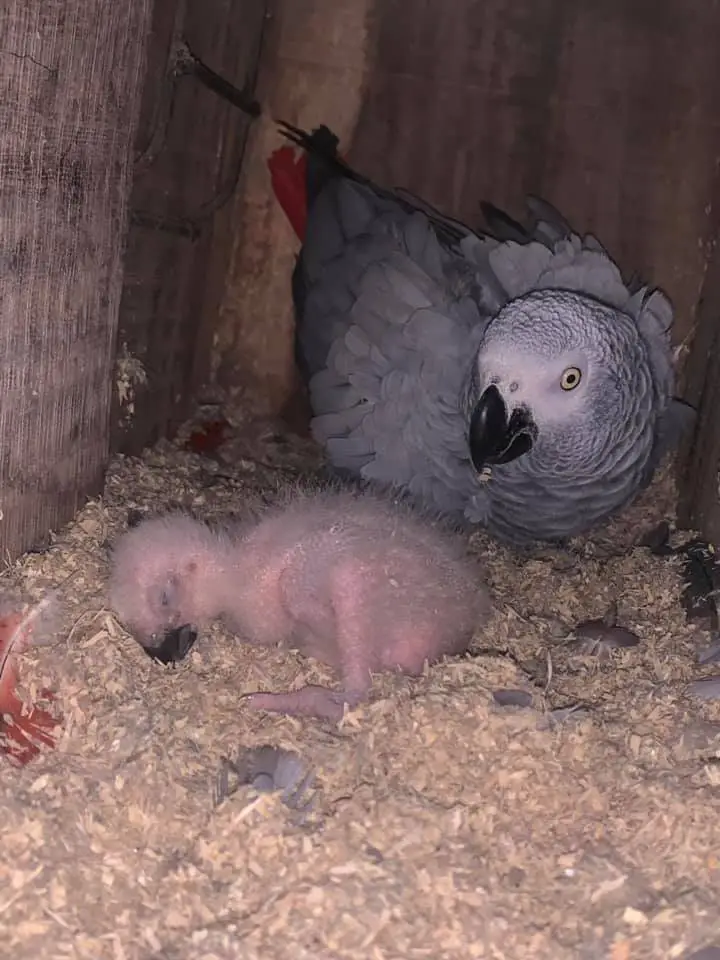
Adopt A Baby Parrot: The parrot is one of the hottest new pets, but also one of the most abandoned. Here is what you need to know before welcoming one of these colorful birds and Adopt A Baby Parrot.

What you need to know before adopting an African Grey Parrot, Adopting a parrot is an exciting activity. In addition to being cute, this animal has a lot of surprises in store during its life in a home. The charm of this type of bird lies in its coat generally, very colorful, but also in the ability of some species to speak by repeating what they hear on a daily basis.
However, a small daily language training session is necessary if you want to enrich his vocabulary. In addition, they are sociable and endearing in nature, even are also naturally smart. Adopting a parrot is ideal for people who need companionship at home because this animal appreciates dialogue.
You can also integrate it into a large family. Nevertheless, there are some species that are better adapted to family life than others. If you want to adopt a parrot and know the essentials for it to flourish in your home, follow this guide.
African Grey Parrot
He is the quintessential talker, the best of all parrots when it comes to the ability to reproduce human language. He is very intelligent, calm, and very affectionate at the same time. Indeed, he will easily attach himself to the one who takes good care of his well-being. You will enjoy being in the company of this bird thanks to its highly developed brain.
How to adopt a parrot?
Before getting a parrot, it is necessary to know the essential conditions to be met for its adoption. First of all, you need to accept its noisy character, because it is part of its nature. Moreover, some individuals obtain it for this reason. You must also be able to meet their needs in order to ensure their well-being in your home. Also, take these few points into account before taking a parrot into your home.

How to choose the right parrot?
To get a parrot, you need to go to a pet store or a breeder. Since it is punishable under French law to buy an animal that is not allowed for sale, these sources remain the safest. It is also not recommended to afford a wild species for export, prohibited to domestication, for ecological reasons. Indeed, there are enough domestic parrots that are marketed in pet stores and breeders nowadays, so it is better to leave wild birds in their natural environment.

To choose the right parrot, avoid immediate contact with the animal. Prefer an observation at a more or less distant distance to analyze its appearance and behavior. A healthy bird should have well-maintained plumage, a sharp look, and nostrils that do not flow. In addition, it is important to choose a parrot that is at least four months old and has been bred by hand or by its parents.
Before the purchase, you must claim the documents that attest to the origin of the animal to avoid falling into illegality. Also, check the ring on one of these legs, if it is closed, the parrot has been well followed since birth. Prefer those who wear closed rings.
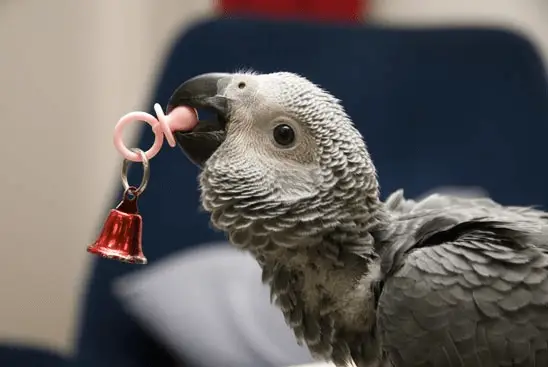
Features of a parrot
Almost all breeds of parrots are able to speak. However, their abilities usually depend on several factors such as their species, their surroundings, their living conditions, etc. Therefore, do not just make your bird speak, it is also essential to play with it.
Know that the parrot is a very sensitive being. He can easily get sick. In this case, it is possible that the animal will stop feeding. In the worst case, it stings itself by tearing off feathers. These reactions are usually due to the fact that he is not properly cared for. It is therefore necessary to dedicate a little time to communicate with your parrot every day.
For its well-being, the bird follows a very precise rhythm in its hours of sleep. The parrot sleeps from sunset until sunrise. He also has to take a nap of about two hours each afternoon. You must therefore organize yourself to respect these schedules to ensure their fulfillment.
His food
A parrot must eat healthily and above all, clean food to stay healthy. This also makes it possible to extend one’s life expectancy. Its daily food should be varied such as seed mixture, fruits, vegetables, etc. You can occasionally give him cooked cereals such as rice, wheat, oats…
Its environment
The adoption of a parrot requires a sanitized or even disinfected place. It is essential to clean the parrot cage on a daily basis because the parrot is very fragile in the face of human bacteria. He can catch various diseases in case of infection and eventually die. Also avoid air pollution caused by agents such as cigarette smoke, paint smell, sprays (insecticidal spray, deodorant, aerosol. ), cosmetics, and electric heating. The parrot has extremely fragile lungs.
African grey hatching eggs
Some breeds of parrots suitable for adoption
There are many species of parrots, with their noisy character as a common point. However, you should also know that there are some who are more garish than others. Your choice will depend on your desires taking into account the specificities of each breed. To help you with the choice, here are some of the breeds of parrots that are the most appreciated and adopted nowadays.
The Amazon
Very intelligent, he can reproduce a complete sentence using it in the appropriate situation. This breed of parrot tends to be noticed by making its entourage laugh with its antics. On the relationship side, he will choose the person who seems to him the most emotional to attach himself more to it compared to the remains of the family.
The Ara
Also a good talker, it stands out for its very colorful appearance. Its main asset lies in its beauty. However, he develops a demanding and capricious character. It is therefore advisable to have some experience on birds before adopting it, as it may not be understood. This situation can have a lot of impact on their relationship with your family.
The Cockatoo
If you want a long-lasting companion, this breed is ideal. Indeed, it can reach fifty. The cockatoo can also reproduce entire sentences. Know that it is also one of the noisiest parrots.
The Joys Of Having A Parrot
SOURCE: Flock of Five
Parrots are magnificent birds to admire. They are very intelligent and the majority of these specimens can learn to speak. Parrots also love to sing, play, and so bring joy and good humor throughout the house. They are also very sociable and affectionate. They become attached to their family, which then becomes their social group. The parrot is one of the most intelligent animals.
A study was indeed carried out on Alex, a gray from Gabon, and proved that he was able to understand concepts such as size, colors, numbers … The intelligence of Alex was then comparable with that of a young child! There is a wide variety of parrots: large, medium, small, of all colors … You will necessarily find the one that suits you.
POINTS TO KNOW
Like humans, the life of parrots is punctuated by different phases which can be annoying. All parrots go through cries, biting, orbiting stages. The bird is also noisy. He screams to get attention in the morning and in the evening. These are the vestiges of life in the wild.
Beware of your furniture! This exotic friend needs space and time to spare. The price of a large cage is to be taken into account. And it will take a lot of love, tenderness, attention, and talk to her. A parrot is for life! Life expectancy is between 50 and 80 years. Some large specimens can even become centenarians.
Even if he is in captivity, he keeps his instincts and you may not understand some of his reactions.
TO REMEMBER
A parrot lives between 50 and 80 years old, adopting it is for life
Creating a social relationship is essential with this animal
Plan to purchase a large cage and a suitable diet
Baby Parrot
Parrot baby animals raised by their parents will have grown up in an aviary where adults are expected to be in this role. The eggs are laid, then hatched, and finally, the chicks are fed in a closed “nest box”. The result of this type of breeding is often the fact that the young bird will maintain a number of habits that will be similar to those of his wild cousins.
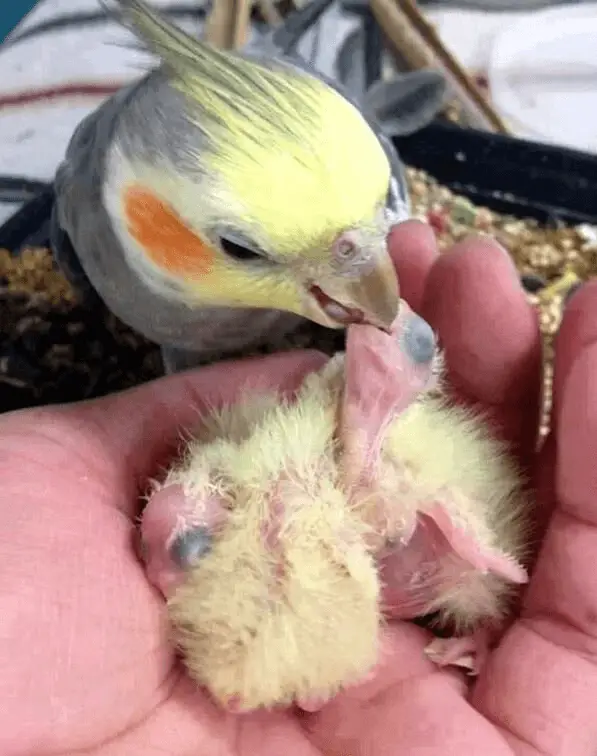
The chick will never be handled by a human until he is weaned by his parents. In fact, most of the time, the only contact the chick has had with a human will not have been very positive. Usually, a parrot baby raised by his parents will have no idea what a human is until he is caught in a net or with a glove or towel.

So it’s not really a surprise, that once arrived home, he screams, claws even bites very aggressively. This little guy does not only need a lot of love, but he also needs an experienced breeder, who will help him during this frightening period of his life.

Very often, this type of bird is actually not intended to become pet. It is more than likely that this chick is supposed to be part of the new generation of captive breeding birds in its aviary. He is there to ensure that the demand for parrots is satisfied in the most human way possible, but it also allows his entire species not to disappear completely.
Hand Raising Baby Parrots
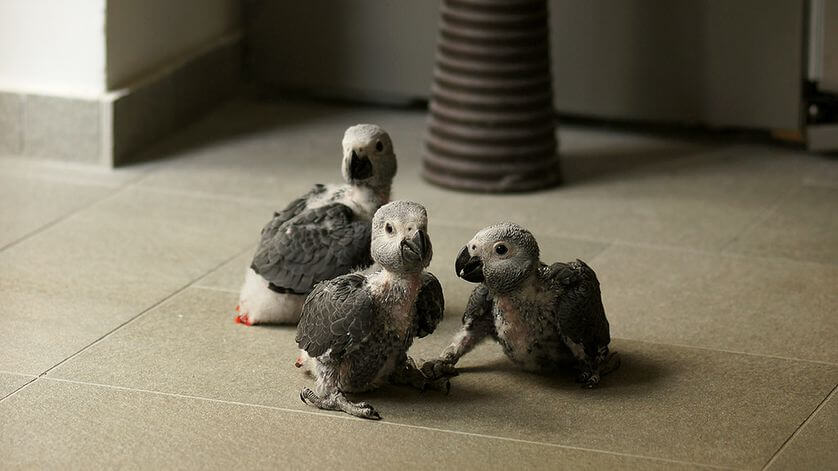
We realize that more and more people want to “jump” into the breeding by hand or are persuaded, at the time of purchase, by skilled sellers to finish hand-raising unweaned chicks.
However, this practice is far from a hobby but requires the opposite of equipment, experience, and availability to any test as the bird is not weaned and autonomous.
It, therefore, seemed interesting to briefly introduce the obligations and difficulties that surround this technique.
1- Specific and expensive equipment!
Breeding by hand from the birth of the African grey parrot can only be done by equipping a quality breeder with heating and ventilation with hygrometry regulated electronically to 1 / 10th degree Celsius. This type of equipment costs several hundred euros.
A breeder must also have an accurate electronic scale at 2 grams (at least a reading deviation of 2 grams represents 10% of the birth weight of a Gray from Gabon.
Adopt a baby ara parrot
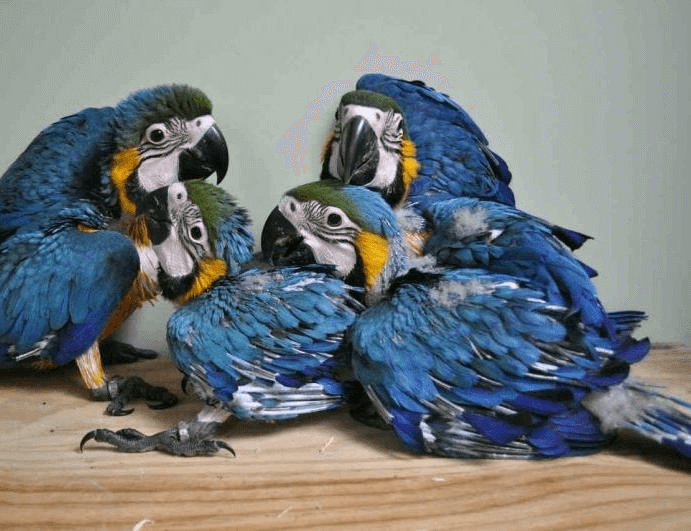
Adopt A Baby Parrot
2 – Irreproachable hygiene!
Hygiene is paramount and the instruments used must be disinfected after each use. Similarly, the farmer must be cleaned by ensuring that the chick does not experience any “difference” in temperature.
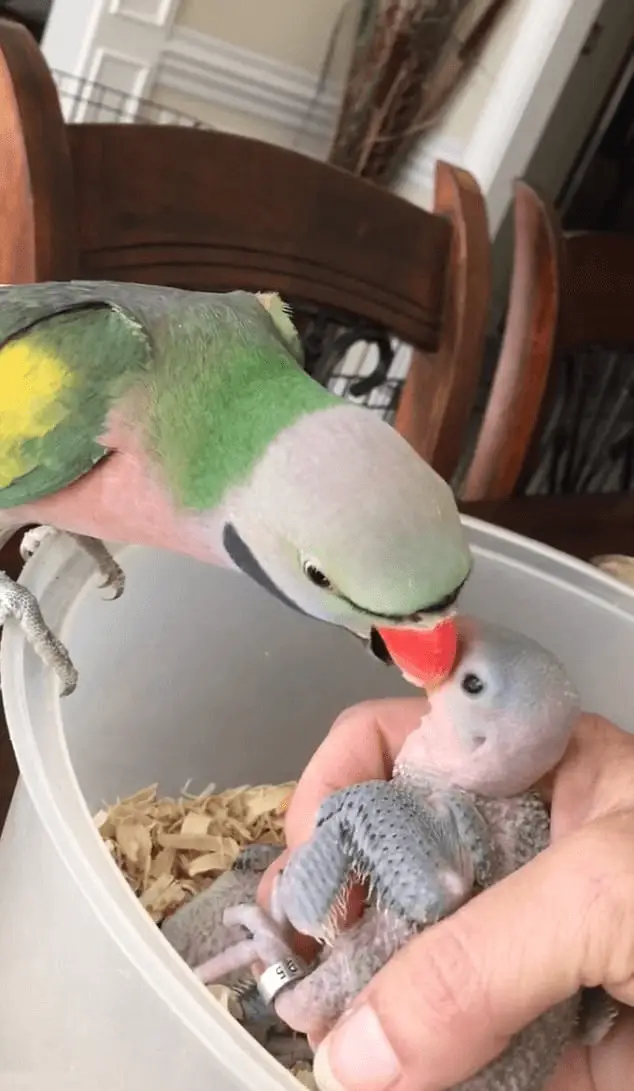
Adopt A Baby Parrot
3 – Full-time availability!
At birth, the feeding is spread over a period of 5 hours to 23 hours.
At each “feed”, time must be allowed for the preparation of the mash, weighing, feeding, cleaning the “nest” and the fledgling after the “feeding”.
The chick should be weighed daily and a weight curve for each bird should be established.
The number of meals will decrease over the weeks and it is only from the 12th week that the bird can start feeding alone. However, it will not be completely autonomous yet.

Adopt A Baby Parrot
4 – A special diet!
The diet given to this baby Parrot is either a “personal” mixture or a pâté sold by a renowned manufacturer.
In 2002, the quality of farmed industrial pies is such that it seems to us that they dethrone personal mixtures for at least three reasons:
Their final composition is known (% proteins,% lipids,% carbohydrates).
Quality controls ensure the reproducibility of manufacture.
When you have only one bird to feed, it is creating an extra galley to make your own mix!
It should be noted, however, that commercially farmed meats are expensive when they are of high quality.
Adopt A Baby Parrot
5 – A necessary experience!
Hand raising is learned on the job and with experience (the best school is to learn from an experienced person).
Books are valuable but do not give skill and nothing replaces the eye and observation of practice.
The weight curves found in books and on the Internet are good indicators of the results to be obtained for a given species. However, if we make a mistake feeding a chick (crop stasis for example) and in the absence of rapid and adapted measurement, the death occurs in 24 to 48 hours. These curves are therefore only guides and each species, and even each bird, is different in its growth needs.
It is also worth mentioning in this article an increasingly common practice on the part of some to sell unweaned birds (ie, less than 4 months old). At this age, the risk of misfeeding remains high, especially as to be sure of selling, some sellers recommend only 2 meals (because an amateur buyer with a job or a professional activity outside can not feed his bird only morning and evening). Under these conditions, the baby bird will receive twice the volume of what should have been distributed at least four times.
This inadmissible practice does not take into account the specific needs of the bird but those of the amateur breeder. For example, it would not come to the idea of anyone to entrust an infant to a nurse who could give him only two baby bottles a day
What an amazing expression is not it …? However, this formula has been passed in popular language for some years – since the soaring popularity of these birds …
If we consider that on average a parrot lives between 50 and 70 years old and always that on average people keep it in their life approximately three to five years, it is, therefore, that on average, a parrot will be adopted and abandoned a dozen times during his life.
Ten adoptive families, ten mourners, and as many times having to get used to a new environment, a new way of life; ten sorrows of heart, and ten new attachments. No intelligent and sane person would want to undergo such treatment! And yet, it is fate that awaits a large number of chicks from their birth in captivity.
Why are people separating from their parrots? There are as many variables as there are humans: “the birth of a child, a sudden fit of allergy, lack of time, it screams, it bites, etc.” But in many cases, the main reason is the laxity shown by these “passionate” at the time of acquisition of their bird. Indeed, if these people had taken the trouble to inquire a little bit, they could have considered before the purchase several points that now seem negative.
Today, they want to leave their bird. They have purchased a cute feather ball, but the bird has matured, so far none of the behaviors have manifested themselves, and in many cases, these people are simply unable to admit these. transformations, to accept that “baby” has grown.
The second-hand parrot comes to us with a lived experience, with antecedents.
Now, in our world of super-communications, it has become very easy to get a “second-hand” parrot, at a fairly attractive price through newspapers, magazines, clubs, and most of all, via the Internet. By cons, never forget that what may seem to you the “deal of the century” can also contain several small surprises that were not planned at the time of purchase.
In fact, these parrots do not come to you like an empty box; they have antecedents which, in many cases, are the source of the windfall. Most parrots are strangely put on sale at the critical age of puberty (2 to 5 years depending on the species), also called, with reason, the stage of affirmation.
It is the period of independence of the bird that often questions the achievements of the juvenile period. Socialization is not yet stable and it is at this point that we see most of the communication problems. This critical period of puberty requires a constant reinforcement of learning and socialization, and many early enthusiasts can not cope with these changes in attitudes on the part of their bird and decide to leave.
Unfortunately, the bird arrives at a crucial period of its evolution, and to live an abandonment at this precise moment risks to insecure it and reinforces several of these undesirable behaviors.
If this bird is adopted by a novice and the parrot’s attitudes are not readjusted before the realization period (maturity), these behaviors may become permanent or at least much more difficult to correct, and that’s when the infernal circle of abandonments and adoptions will begin. The parrot will thus pass from hand to hand, each time making stays shorter and shorter in each of his new “families”.
It will be necessary to inquire about the history of the parrot that one wishes to adopt, its behavior, and its reactions.
Before closing the case impulsively, find out the real reasons why this bird seems so good. Some of these parrots have developed over time behavioral problems that can range from negligible to really serious (screaming, biting, pecking, various stereotypes, fear of children, aggression towards certain types of people, etc.). Are you sufficiently experienced or prepared to deal with such an eventuality?
To do it right, you will have to play detective: how many known families before that of the seller (try to contact the previous “owner”), the age of the bird, its origin (name of the breeder or of pet shop), age of weaning, temperament, etc.
Find out about the bird’s medical history and, if possible, ask for access to their medical records. The more information you have about Coco, the better you’ll be able to tell if you’re the right person to care for or help.
Adopting a “second hand” bird should never be a pecuniary question; in such a case, as much as the bird will come out losing the adventure. I do not think that it would be of any use to this parrot to take it with you to make him live a little later the upheavals of a new abandonment. Do not make yourself a “savior” of this bird; Adopting a “second hand” parrot is a matter of love, compassion, and dedication and you have to do it in a very long-term relationship (the length of your life).
Upon arrival, the parrot will show a reserved attitude.
Some parrots can radically change their attitude just by changing the environment, but this is not always the case. Earning the trust of an older bird or having a history of abuse and/or neglect can be a long journey that will take a lot of time and patience.
These birds have the opportunity to create very strong emotional ties with a new human, but do you say that these links are not included with the purchase contract; sometimes it will be love at first sight, but most of the time, you will have to sell your salad. You may need help understanding and taming your parrot or changing one or more behaviors.
This need for help will not seem obvious to you in the first days after the arrival of the bird. The parrot is an animal suspicious of nature, he will have a reserved attitude and will use these first days to observe his environment and tame this new territory.
During this period, all territories are neutral for the bird, including the “human territories” and he does not manifest any of the behaviors that led him to abandonment by his previous families. That’s when you have to act. We must not leave the isolated bird in his cage!
You have only these few days, where the bird seems fragile, to establish contact on a fair basis with him and, during this short period of ten days, your attitude should not leave room for error.
Anything that the parrot retains during this time will be very difficult to modify and your inexperience may reveal behaviors that were not present at the start.
If you think you do not have the necessary skills, it’s best to seek the right help in the first few days after the bird arrives in your home, so that the relationship can start on a new foundation and not on ancient patterns of the bird that may quickly resurface past this critical period.
When properly tamed and socialized, the second-hand parrot can become a wonderful companion.
Older parrots of “second-hand” have the opportunity to become the most adorable companions there are. In my house, my best relationships are with these birds of second, third, or fourth chance and my biggest attachments too. These birds seem to enjoy their new life, which is very different from a bird adopted at a very young age who takes for granted that “that’s life”.
Naturally, these birds have asked me for a greater investment of time and energy, brought me a lot of consternation, but also my greatest joys before reaching a balance and becoming those wonderful companions that enchant my life today… I knew in what galley I was embarking and I assumed all the responsibility. And you, do you know what adventure you are about to set foot on?
So, before embarking on an adventure you do not know about, make sure you have all the resources you need to help you assess your expectations and determine if this bird is the right choice for you. you and, finally, help you in your approach to offer this bird the environment it needs, both physically and psychologically. Your motivations should in no way be guided by financial considerations, but by the desire to succeed in the most perfect companionship.


